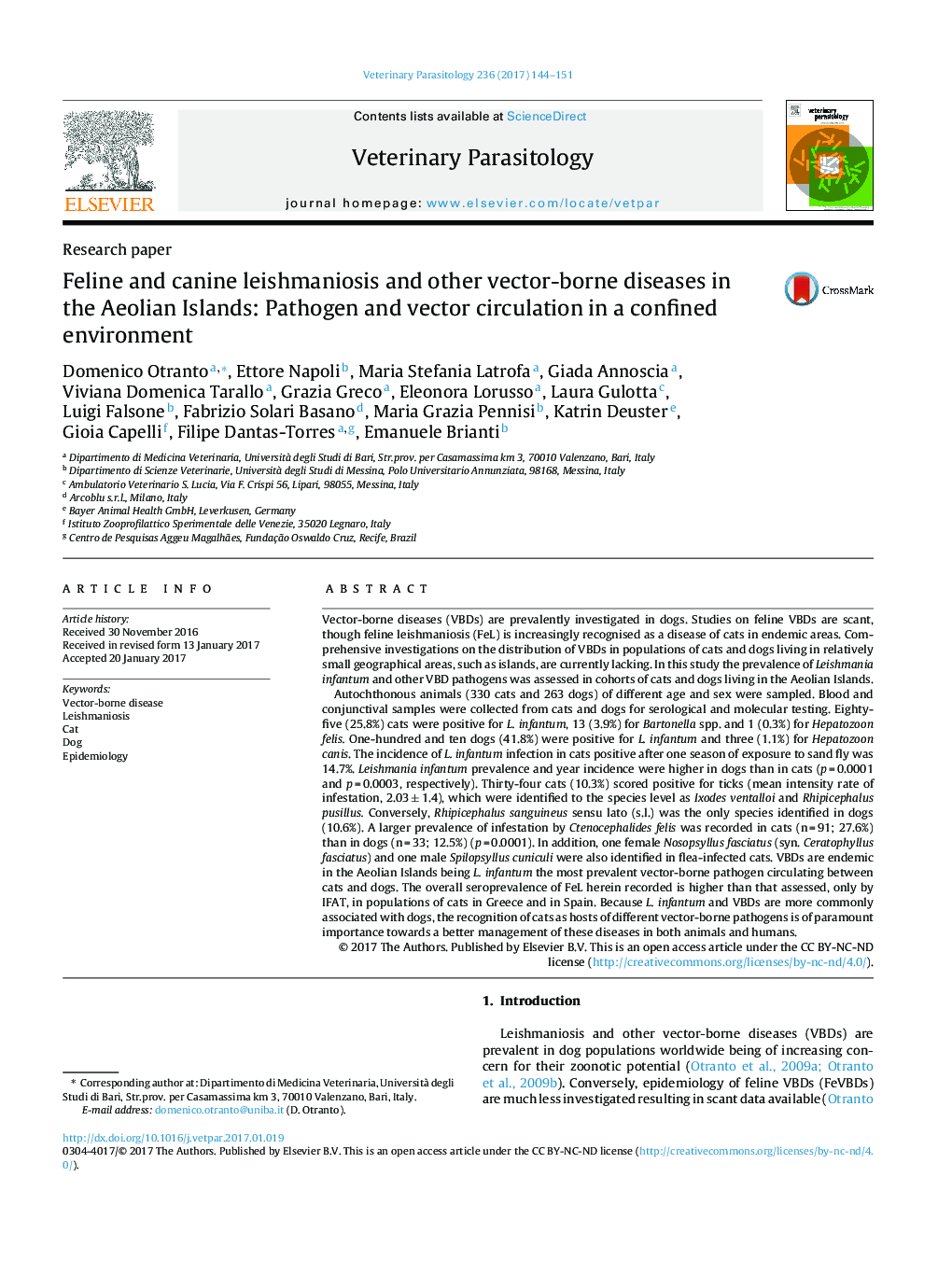| کد مقاله | کد نشریه | سال انتشار | مقاله انگلیسی | نسخه تمام متن |
|---|---|---|---|---|
| 5545836 | 1555640 | 2017 | 8 صفحه PDF | دانلود رایگان |
- Feline and canine leishmaniosis and other vector-borne diseases been investigated in a confined environment (the Aeolian Islands, Sicily, Italy).
- Studies on feline VBDs are scant, though feline leishmaniosis (FeL) is increasingly recognised as a disease of cats in endemic areas.
- Autochthonous animals (330 cats and 263 dogs) of different age and sex were sampled and blood and conjunctival swabs and 85 (25.8%) cats and 101 dogs (41.8%) scored positive for L. infantum either molecularly and/or at serology.
- Cats (10.3%) were positive for ticks (Ixodes ventalloi and Rhipicephalus pusillus) and dogs (10.6%) for Rhipicephalus sanguineus sensu lato (s.l.).
- The incidence of L. infantum infection in cats positive after one season of exposure to sand fly was 14.7%.
- The recognition of cats as hosts of different vector-borne pathogens is of paramount importance towards a better management of these diseases in both animals and humans.
Vector-borne diseases (VBDs) are prevalently investigated in dogs. Studies on feline VBDs are scant, though feline leishmaniosis (FeL) is increasingly recognised as a disease of cats in endemic areas. Comprehensive investigations on the distribution of VBDs in populations of cats and dogs living in relatively small geographical areas, such as islands, are currently lacking. In this study the prevalence of Leishmania infantum and other VBD pathogens was assessed in cohorts of cats and dogs living in the Aeolian Islands.Autochthonous animals (330 cats and 263 dogs) of different age and sex were sampled. Blood and conjunctival samples were collected from cats and dogs for serological and molecular testing. Eighty-five (25.8%) cats were positive for L. infantum, 13 (3.9%) for Bartonella spp. and 1 (0.3%) for Hepatozoon felis. One-hundred and ten dogs (41.8%) were positive for L. infantum and three (1.1%) for Hepatozoon canis. The incidence of L. infantum infection in cats positive after one season of exposure to sand fly was 14.7%. Leishmania infantum prevalence and year incidence were higher in dogs than in cats (p = 0.0001 and p = 0.0003, respectively). Thirty-four cats (10.3%) scored positive for ticks (mean intensity rate of infestation, 2.03 ± 1.4), which were identified to the species level as Ixodes ventalloi and Rhipicephalus pusillus. Conversely, Rhipicephalus sanguineus sensu lato (s.l.) was the only species identified in dogs (10.6%). A larger prevalence of infestation by Ctenocephalides felis was recorded in cats (n = 91; 27.6%) than in dogs (n = 33; 12.5%) (p = 0.0001). In addition, one female Nosopsyllus fasciatus (syn. Ceratophyllus fasciatus) and one male Spilopsyllus cuniculi were also identified in flea-infected cats. VBDs are endemic in the Aeolian Islands being L. infantum the most prevalent vector-borne pathogen circulating between cats and dogs. The overall seroprevalence of FeL herein recorded is higher than that assessed, only by IFAT, in populations of cats in Greece and in Spain. Because L. infantum and VBDs are more commonly associated with dogs, the recognition of cats as hosts of different vector-borne pathogens is of paramount importance towards a better management of these diseases in both animals and humans.
Journal: Veterinary Parasitology - Volume 236, 15 March 2017, Pages 144-151
